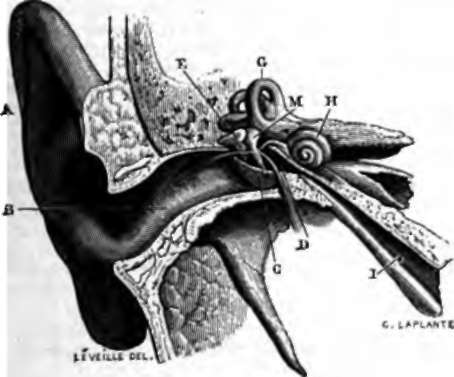External Ear
Description
This section is from the book "Wonders Of The Human Body", by Auguste Le Pileur. Also available from Amazon: Wonders of the Human Body.
External Ear
This is the least complicated portion of the organ; it is composed of the pavilion, or projecting party and the auditory canal.
The pavilion of the ear is similar, as the name implies, to the open portion of wind-instruments or a speaking-trumpet It is an acoustic horn, which gathers the sonorous waves, and conducts them to the intricacies of the auditory apparatus. It consists of an elastic cartilaginous layer covered with a delicate skin, and is curiously modelled. Its border, rounded in its upper portion, and folded back on itself, forms the rim or helix, and terminates at the lower portion in the lobe. The concha is in the centre, and is bounded behind by the antihelix, and terminates in the auditory canal. The projections of the tragus and antitragus, separated by an elliptical slope, protect the orifice of this canal, and a down, which might be called the lashes of the ear, sifts the air as it passes into the organ.

Fig. 43. Section shoving the different parts of the ear.
A. Pavilion, or projecting ear.
B. External auditory canal.
C. Membrana tympani.
D. Tympanum.
E. Incus, or anvil.
M. Malleus, or hammer.
H. Cochlea, or shell. I. Eustachian tube.
The pavilion of the ear is directed forward, projects from the head, and its lines are in beautiful harmony with the oval of the face.
De Blainville compares the curves and the surface of the pavilion of the ear to those of the head. According to this naturalist the curve of the superior portion of the pavilion corresponds to that of the cranium, and the free border of the rim describes a curve parallel to that which marks the temporal fossa. When the head is not prominent in it middle region, and the temporal fossę are slightly marked, the rim is absent; it is, on the contrary, broad and prominent when the arch of the skull overhangs the temporal fossę. The concha corresponds to the upper jaw, and is proportional to it; and the prominence of the origin of the helix represents that of the zygomatic arch; and lastly, the profile of the lobe is like that of the upper jaw. It is remarkable that this lobe exists only in man, and that man only has also a prominent and angular chin.
The auditory canal, which represents the tube of the acoustic trumpet formed by the external ear, is cartilaginous next the concha, and the remaining part is excavated in the petrous or stony portion of the temporal bone. This canal is about one and a fifth inch in length, and its entire disposition is such that foreign bodies suspended in the air cannot pass with it to the membrana tympani. It is bent near the concha in such a manner that the air, in transmitting sound to the middle ear, does not penetrate in right lines, thus protecting the sensibility of the membrane.
Continue to:
